| (Click the pictures to see a larger version.) |
 |
San Jose Historic Landmark #1
The Peralta Adobe is the oldest building in San José and the only remaining structure from the original Pueblo de Guadalupe, the first town established by the Spanish. The adobe house was built in 1787 by Manuel Gonzalez, an Apache who came to California with the Juan Bautista de Anza expedition in 1775. Luis Maria Peralta also traveled with the Anza expedition at the age of 16. Peralta enlisted in the Spanish army in 1781, and served for 45 years in the presidios at Monterey, Santa Cruz, San Francisco, and San José. He and his wife Maria Loreto Alviso (who also came to California with the Anza expedition) had 17 children. Nine of the children survived to adulthood. Because of his service to Spain, Peralta was given one of the largest land grants of the time. In 1820, his Rancho de San Antonio stretched as far as the eye could see in all directions—its 44,000 acres included the present day cities of Albany, Berkeley, Oakland, Alameda, Piedmont, and parts of San Leandro. |
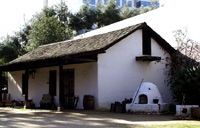 |
Adobe House
Luis Maria Peralta and his family acquired the adobe house in 1804. In 1807, Peralta was appointed “Comisionado” of the Pueblo de Guadalupe. Peralta was the top official and supervised the government of the Pueblo de Guadalupe. The primary function of San José was to supply the nearby presidios with food, so Peralta spent most of his time overseeing farming. He served as Comisionado until the Mexican government abolished his post when México took control of California from Spain in 1822. During his lifetime, four flags flew over his adobe: the Spanish flag, the Mexican flag, the California “Bear Flag,” and finally, the American flag. Peralta died in 1851. |
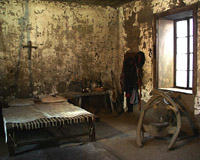 |
Bedroom
This room is furnished with items typical of the Spanish period, when trade with other countries was not allowed. During this period, it was hard to get items that the ranchos could not make themselves. Rooms were usually very plain and simple. The chair under the window is made of whale bone. |
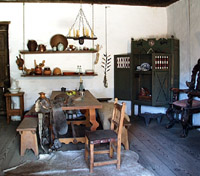 |
Front Room
This room is furnished with items from the Mexican period, when trade with other countries was permitted. While the hide rug, saddle, and wooden furniture might have been made on the rancho or in Mexico, the china would have probably come from trade with American merchants. |
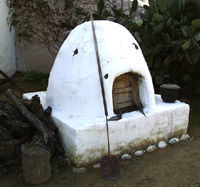 |
Horno
All cooking was done outside the two-room adobe house. Bread was baked inside the horno (beehive) oven. A wood fire was built inside the horno and allowed to burn until the entire oven was very hot. Then the embers were removed and the bread placed inside the oven. A sack soaked with water was wrapped around the wooden door so it would not catch fire. |
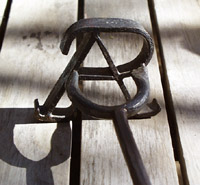 |
Peralta Brand
There were few fences in early California. Cattle were allowed to roam free and graze wherever they could find food. Twice a year the cattle were rounded up and branded. The brands usually featured the initials of the owner or the ranch. In the Peralta brand you can see the P from Peralta and the A from Rancho San Antonio. Heated in an open fire, the brand burned away the hair of the cattle, leaving a scar that stood for a certain rancho (ranch). The long handle on the branding iron protected the vaquero (cowboy) from the heat of the iron and the smell of the burning hair. |
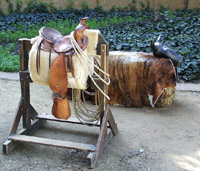 |
Roping Skills
From an early age, rancho children would practice using a lariat. Most children learned to ride a horse before they learned to walk. Today at the Peralta Adobe children practice sitting in a stationary saddle and try to rope a stationary steer. After feeling how difficult it is to handle the rope when everything stays still, it is amazing to imagine trying to rope a running steer from the back of a galloping horse! |
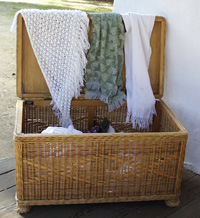 |
Shawls
Rancho women and girls wore shawls every day. The shawls were used for warmth, to cover the head when wet or dusty, and to carry babies or other things. Some shawls would be plain and sturdy for everyday use, others would be fancy for wearing to church or to fiestas (parties). |
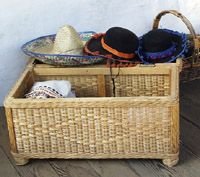 |
Sombreros
Wide brimmed sombreros (hats) provided protection from both sun and rain while working outside. Worn most often by men and boys, women and girls would also wear sombreros while riding. |
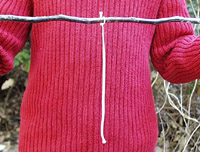 |
Candles
Candle dipping by hand is a tedious process. The wick has to be dipped over and over into the hot wax, cooling between dips. While making candles, people would often sing to make the chore more enjoyable. |
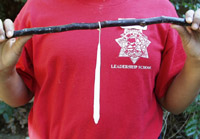 |
Candles
It takes many many dippings to make the candle thick enough to use. The Peralta family would have made candles out of tallow (cow fat), which tends to smoke and smell when burned. Candles out of wax like this would have been saved for very special occasions. |
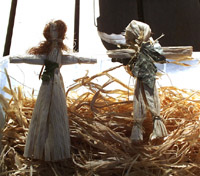 |
Corn Husk Dolls
Rancho children did not have many toys. Children learned to make their own toys out of everyday materials. These dolls are made out of corn husks. |
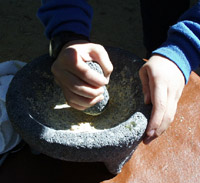 |
Grinding Spices
Sugar and spices were rare and expensive and were usually saved for special occasions. Rock sugar and cinnamon were crushed in a stone mortar with a pestle, releasing a wonderful aroma. |
![]()
![]()
![]()